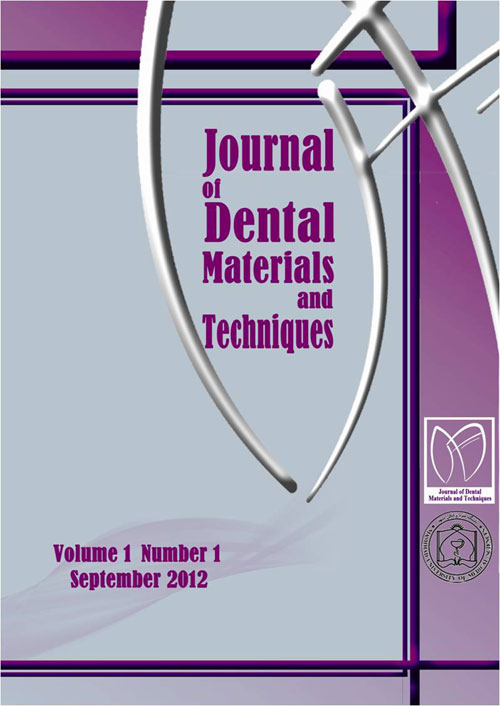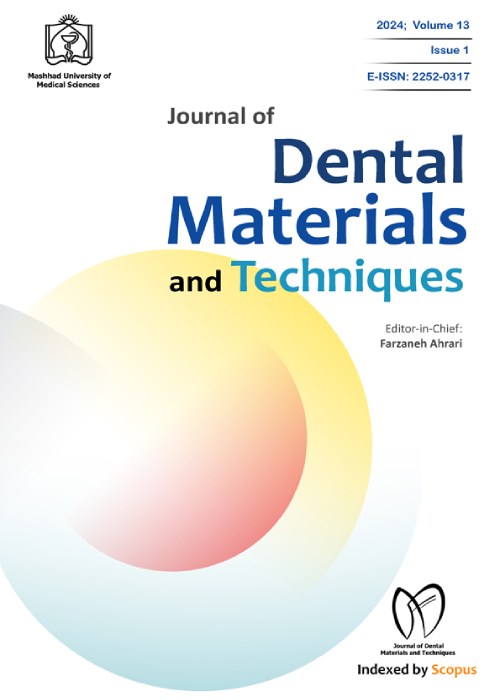فهرست مطالب

Journal of Dental Materials and Techniques
Volume:11 Issue: 2, Spring 2022
- تاریخ انتشار: 1401/04/12
- تعداد عناوین: 8
-
-
Pages 68-74Introduction
The present study aimed to investigate the effect of adding TiO2 nanoparticles on the flexural strength and hardness of two dental composites.
MethodsTiO2 nanoparticles were prepared and added to two flowable dental composites (Beautifil Flow Plus and Clearfil AP-X Flow) at 0, 0.2, 0.5, and 1% (w/w) which was confirmed by SEM and TEM analysis. Mixing was manually performed using Lentulo Spiral Paste Carrier. The specimens were divided into 8 groups of 10 according to the type of composites and different concentrations of TiO2 nanoparticles. Bar-shaped specimens (2×2×25 mm) were fabricated in a half-split stainless steel mold and cured for 40 s by an LED curing system. Flexural strength was evaluated using a universal testing machine. Surface microhardness was also measured by the Vickers microhardness tester.
ResultsFor the two tested composites, flexural strength increased by 0.5% TiO2 nanoparticles concentration. The flexural strength of Clearfil AP-X Flow combined with 0.2, 0.5 and 1% TiO2 nanoparticles were 112.54±12.87 (P>0.05), 114.62±8.14 (P>0.05), and 99.92±6.23 (P<0.05), respectively. Also, for Beautifil Flow combined with 0.2, 0.5 and 1% TiO2 nanoparticles were, 92.21±4.26 (P<0.05), 94.05±5.36 (P<0.05) and 74.17±9.43 (P<0.05), respectively.
ConclusionAdding TiO2 nanoparticles to Clearfil AP-X Flow composite decreased the hardness; however, adding TiO2 nanoparticles by 1% concentration increased the surface hardness of Beautifil Flow and reached its maximum value. Also, TiO2 nanoparticles at very low concentrations enhance the flexural strength of dental flowable composites.
Keywords: flowable composite, Nanoparticles, surface hardness, Titanium dioxide -
Pages 75-83IntroductionThe use of acrylic appliances in the oral cavity warrants biocompatibility evaluation. This study aimed to carry out an in vivo investigation of the cytomorphometric changes of oral mucosa among children undergoing acrylic removable orthodontic appliances.MethodsIn this observational clinical study, acrylic removable orthodontic appliances were delivered to 25 orthodontic patients and followed for 3 months. Mucosal samples were collected by gentle brushing of the internal part of the right and left buccal mucosa before appliance delivery (T0) and 1 week (T1), 1 month (T2), and 3 months (T3) following appliance delivery. The cells were immediately prepared for cytomorphometric analysis.ResultsThere was no significant difference in the nuclear area between different time intervals. Cytoplasmic area in the right side of the buccal mucosa was significantly larger 1 month following appliance delivery (T2), compared to T0 (P=0.018) and T1 (P=0.036). On the right side, nuclear to cytoplasmic ratio values in T2 were significantly less than those in T0 (P=0.008) and T1 (P=0.002). Moreover, T3 values were lower than T1 values (P=0.048). The results of micro-nucleation and apoptosis analysis did not show statistically significant differences between different time intervals.ConclusionOrthodontic acrylic appliances may not be a factor in inducing morphologic changes of oral mucosa cells; nevertheless, they may promote some transient cytometric effects. It seems that they do not cause any significant damages to the oral mucosa in long term.Keywords: Acrylic resins, Cytotoxicity, Orthodontics
-
Pages 84-92IntroductionDifferent techniques and materials have been introduced over time to improve the quality of root canal treatment. This study aimed to compare the quality of root canal obturation using three root canal obturation techniques based on the existing void using cone beam computed tomography imaging techniques.MethodsThirty-three single canal teeth were selected and the root canals were prepared. The roots were obturated with single-cone, lateral compaction with cold gutta-percha, and vertical compaction techniques. Afterward, the roots were scanned, and the presence of voids in the 1-, 3-, 5-, and 7-mm sections of the root apex was investigated, and then the area and volume of voids were calculated by Mimics 10.01 software.ResultsThe highest percentage of voids presence in all groups was detected in the 7-mm section of the apex (60.6%) , while the lowest percentage was found in the 1-mm section of the apex (12.1%).ConclusionThere was no significant difference between the three techniques evaluated in this study in terms of void size, void volume, and obturation quality. Voids were present in all samples. Considering the technique used to obturate the root canals, voids were different in terms of shape and volumeKeywords: Bioceramic sealer, CBCT, lateral compaction, TotalFill, vertical compaction
-
Pages 93-102Introduction
Laser diode irradiation, the use of fluoride varnish, and casein phosphopeptide-calcium amorphous phosphate (CCP-ACP) paste have been suggested as effective methods to increase the enamel resistance to decay. The present study aimed to investigate the effect of fluoride varnish, CPP-ACP paste, and diode laser radiation on the microhardness of demineralized enamel.
MethodsIn this experimental study, 78 extracted human premolar teeth were selected and sectioned into two buccal and lingual halves. The samples were immersed in demineralization solution, and primary micro-hardness was measured. Thereafter, the samples were randomly assigned to six groups: control group, 5% fluoride varnish, CPP-ACP paste, diode laser (2W, 940nm) for 40 sec, laser combined with fluoride varnish, and CPP-ACP paste in combination with laser. The microhardness of the samples was measured again after different treatments. Data were analyzed in SPPS software (version 23) using repeated measures analysis of variance (RM ANOVA) (P<0.05).
ResultsThere was no significant difference in the microhardness values among different groups (P<0.05). The comparison of the mean microhardness between before and after treatment for each group revealed a significant difference in the enamel microhardness only in the CPP-ACP paste (P=0.003) and diode laser (P=0.009) groups.
ConclusionAs evidenced by the results of this study, the use of fluoride varnish, CPP-ACP paste, and diode laser radiation did not increase the microhardness and remineralization of tooth enamel. Moreover, laser diode irradiation with the parameters used in this study does not enhance the remineralization effect of fluoride varnish and CPP-ACP paste.
Keywords: CPP-ACP, Diode laser, enamel microhardness, enamel remineralization, fluoride varnish -
Pages 103-109IntroductionIntroductionThe present study aimed to evaluate the coronal discoloration of human teeth induced by using a new Endoseal MTA compared to an AH Plus Sealer.MethodsA total of 40 premolars extracted for orthodontic reasons were used in the present study. Then, the teeth were incised in the coronal third of the root 3 mm below the cementoenamel junction. Samples were randomly allocated to two experimental groups (group 1: AH Plus sealer, group 2: Endoseal MTA) and 6 teeth as the negative control group. The color evaluation was determined at four different times: before placing sealers (T0), 1 month (T1), 3 months (T2), and 6 months (T₃) after that with an intraoral spectrophotometer. Data were analyzed using Multivariate Test and Hotelling's Trace. A P-value <0.05 was considered statistically significant.ResultsThe Endoseal group showed discoloration after 1 and 3 months of the placement of sealer as AH Plus sealer. Also, discoloration of the AH Plus group was higher than that of the Endoseal group after 3 months; however, it was not significant (P˃0.05). Furthermore, discoloration of the Endoseal group was significantly higher than that of the AH Plus group after 6 months (P<0.05). Discoloration tended to decrease until 6 months in both groups.ConclusionThe Endoseal group indicated discoloration which is comparable to AH Plus in 1 and 3 months; however, discoloration in the AH Plus group decreased compared to the Endoeseal MTA group after 6 months.Keywords: AH Plus, mineral trioxide aggregate, Root Canal Sealer, Tooth discoloration
-
Pages 110-117IntroductionThe quality of root canal treatment depends on the sealing ability of root canal obturation materials. Sealers help create an impenetrable seal. This study aimed to compare the sealing ability of AH Plus and Sure-Seal Root sealers by the fluid filtration technique.MethodsThis in-vitro study evaluated 80 extracted human mandibular second premolars. After initial preparation, the teeth were randomly divided into two experimental groups (n=35) and positive and negative control groups (n=5). The experimental groups were obturated with AH Plus sealer and Sure-Seal Root sealer. The AH Plus and the Sure-Seal Root groups were obturated with the lateral condensation technique and the single-cone technique, respectively. Apical leakage was assessed at two intervals of 1 week and 3 months, evaluated by the fluid filtration technique, and compared between the two groups using Student’s t-test.ResultsNo significant differences were observed between the two groups in 7 days. However, after 90 days, the AH Plus group exhibited significantly less leakage than the Sure-Seal Root group. The microleakage of AH Plus decreased over time (P<0.05).ConclusionIn this study, AH Plus exhibited significantly better sealing ability than Sure-Seal Root in the long term.Keywords: AH Plus, Apical microleakage, fluid filtration, Sure-Seal Root
-
Pages 118-126IntroductionThis study aimed to investigate the effect of liposomal and emulsion forms of topical anesthesia on pain reduction during dental anesthesia.MethodsThe study was a randomized clinical trial with a split-mouth design conducted on 15 patients who were referred to a private dental clinic and needed injectable anesthesia for flap surgery in the posterior maxillary area. First, one of the four concentrations (2%, 5%, 7.5%, and 10%) of the emulsion form of Lidocaine-Prilocaine topical anesthesia was applied on one side of the maxilla, and two weeks later, four concentrations of the liposomal form were applied on the other side. These areas were randomly selected for topical anesthesia before injecting anesthesia into the vestibular area. The amount of pain caused by needle insertion was measured by the Visual Analogue Scale.ResultsThe comparison of the emulsion and liposomal forms of Lidocaine-Prilocaine topical anesthesia indicated that 5% of the emulsion form and 7.5% of the liposomal form demonstrated the lowest VAS scores; however, the comparison of different concentrations of the emulsion (P=0.46) and liposomal forms (P=0.64) did not indicate any significant difference. There was not any statistically significant difference between liposomal and emulsion forms regarding the same concentrations (P=0.75).ConclusionDespite the longer substantivity of the liposomal form of Lidocaine-Prilocaine topical anesthesia on the oral mucosa, compared to that of the emulsion form, the findings of the present study revealed that different concentrations of topical anesthesia did not significantly differ in terms of pain reduction efficacy.Keywords: Dental pain, Emulsion form, Lidocaine-Prilocaine, Liposomal form, Topical anesthesia
-
Pages 127-137IntroductionThe impact of Candida-associated denture stomatitis has been vastly discussed in the literature, starting from simple routine oral hygiene practices to the use of the denture itself as a drug delivery unit. Since candidiasis tends to keep recurring, the use of antifungal drugs in the denture or liner provides the benefit of placing the patient under oral drug intake for a long period of time. This in-vitro study aimed to assess the release of chlorhexidine from the acrylic resin discs made from two resins, heat cure and light cure. The study also intended to assess the presence of the drug release and its sufficient effectiveness to be reproduced in-vivo in the treatment of oral candidiasis.MethodsStandard chlorhexidine solution, Chlorhexidine treated heat cure, and light cure resin disc soaked solutions were subjected to test under high-performance liquid chromatography (HPLC) and scanning electron microscopy for the release of chlorhexidine.ResultsThe HPLC analysis of heat cure resin demonstrated that the area and height of chlorhexidine release were comparable to those of the standard chlorhexidine solution. This implies the local release of chlorhexidine in-vitro.ConclusionIn this study, it was found that chlorhexidine release in heat cure discs is less when compared to the standard stock solution; nonetheless, it is good enough to reach the minimum inhibition concentration of chlorhexidine to be effective against candidiasis. Although this study was limited in nature, the results raised hope for further evaluation of dentures as a drug delivery system.Keywords: acrylic resin, candidiasis, Chlorhexidine, High-performance liquid chromatography


